Employee Engagement in Royal Marsden's Cherry Tree Coffee Shop Project
VerifiedAdded on 2023/04/23
|11
|3066
|481
Project
AI Summary
This research project aims to identify the nature of employee engagement at the Cherry Tree Coffee Shop and Restaurant in the Royal Marsden Hospital in Sutton. It assesses the impact of excellent employee engagement on employees, identifies various engagement tactics, evaluates the link between employee participation and organizational performance, and suggests strategies to increase the effectiveness of employee engagement programs. The literature review examines the impact of employee engagement on employees, tactics for employee engagement, and the link between employee participation and organizational performance. The research employs an interpretivist philosophy and a deductive research approach, utilizing both primary and secondary data collection methods to answer research questions about the influence of employee engagement, engagement tactics, and the impact of employee participation on organizational performance.
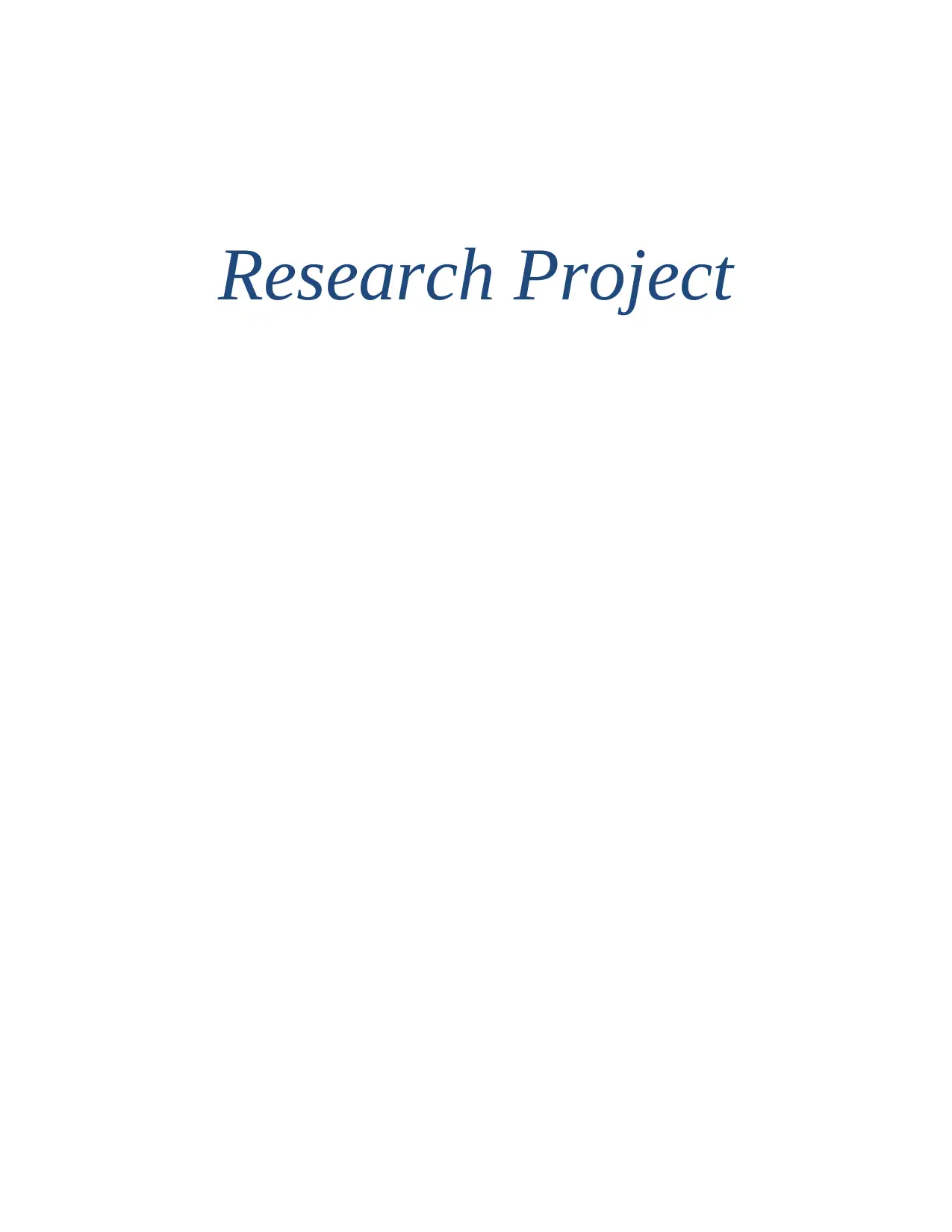
Research Project
Paraphrase This Document
Need a fresh take? Get an instant paraphrase of this document with our AI Paraphraser
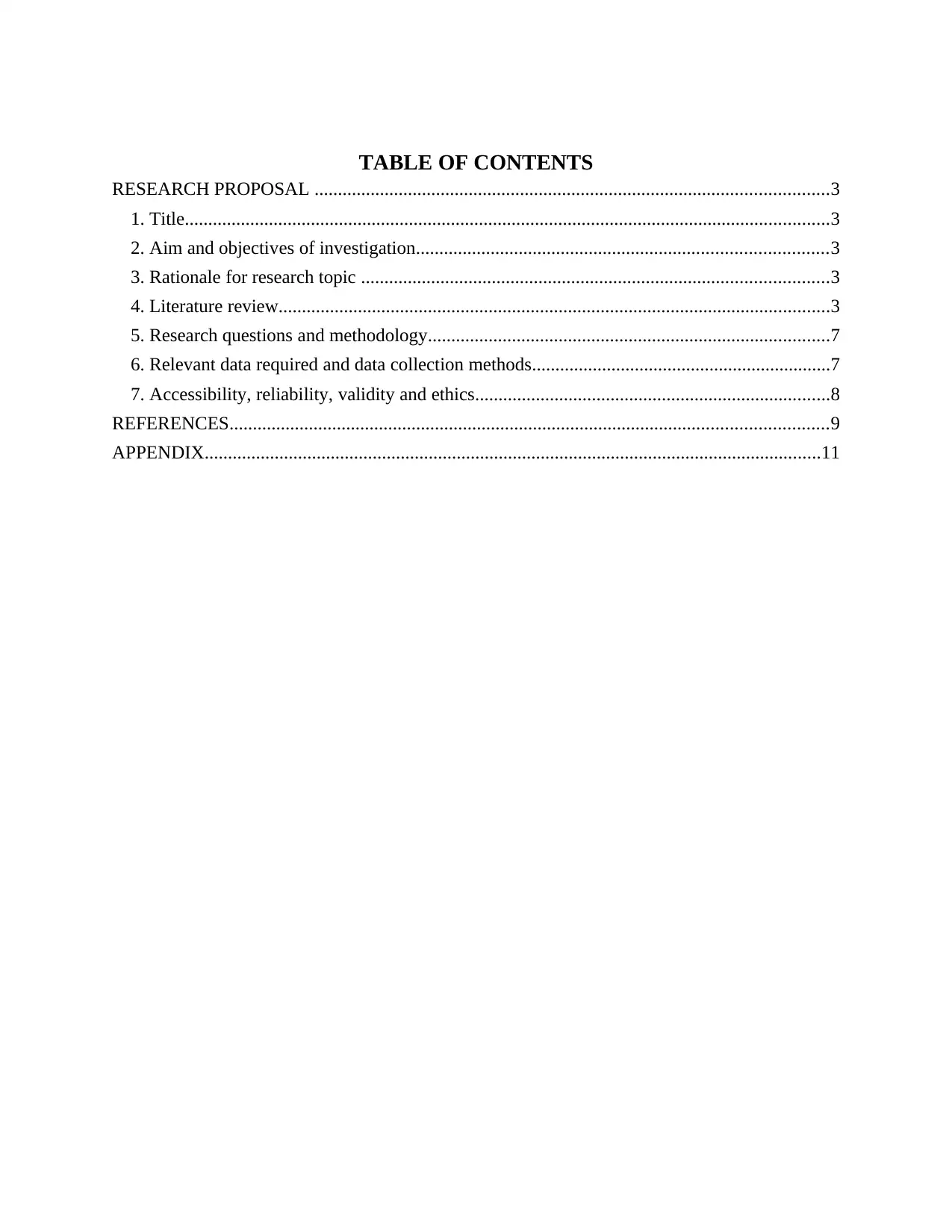
TABLE OF CONTENTS
RESEARCH PROPOSAL ..............................................................................................................3
1. Title..........................................................................................................................................3
2. Aim and objectives of investigation........................................................................................3
3. Rationale for research topic ....................................................................................................3
4. Literature review......................................................................................................................3
5. Research questions and methodology......................................................................................7
6. Relevant data required and data collection methods................................................................7
7. Accessibility, reliability, validity and ethics............................................................................8
REFERENCES................................................................................................................................9
APPENDIX....................................................................................................................................11
RESEARCH PROPOSAL ..............................................................................................................3
1. Title..........................................................................................................................................3
2. Aim and objectives of investigation........................................................................................3
3. Rationale for research topic ....................................................................................................3
4. Literature review......................................................................................................................3
5. Research questions and methodology......................................................................................7
6. Relevant data required and data collection methods................................................................7
7. Accessibility, reliability, validity and ethics............................................................................8
REFERENCES................................................................................................................................9
APPENDIX....................................................................................................................................11
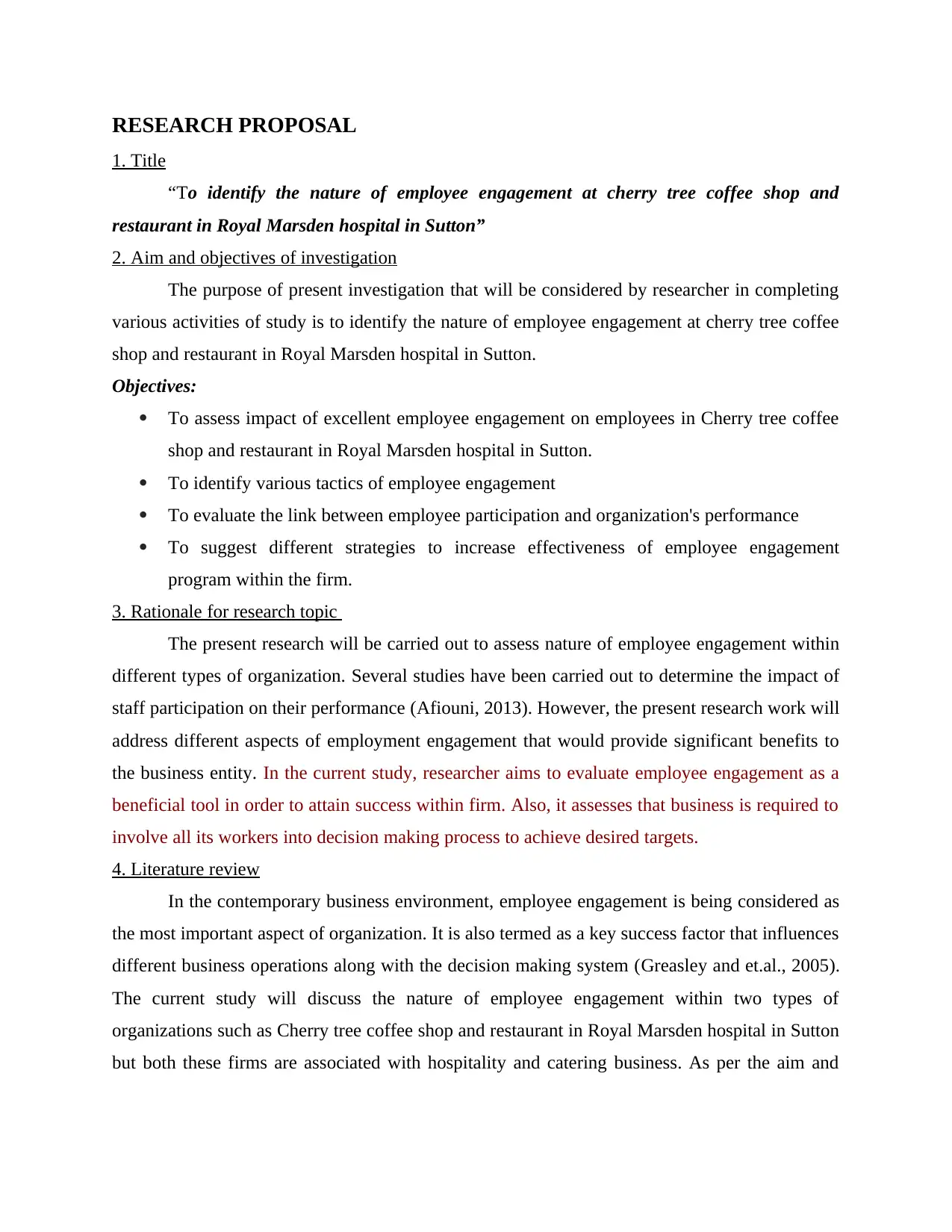
RESEARCH PROPOSAL
1. Title
“To identify the nature of employee engagement at cherry tree coffee shop and
restaurant in Royal Marsden hospital in Sutton”
2. Aim and objectives of investigation
The purpose of present investigation that will be considered by researcher in completing
various activities of study is to identify the nature of employee engagement at cherry tree coffee
shop and restaurant in Royal Marsden hospital in Sutton.
Objectives:
To assess impact of excellent employee engagement on employees in Cherry tree coffee
shop and restaurant in Royal Marsden hospital in Sutton.
To identify various tactics of employee engagement
To evaluate the link between employee participation and organization's performance
To suggest different strategies to increase effectiveness of employee engagement
program within the firm.
3. Rationale for research topic
The present research will be carried out to assess nature of employee engagement within
different types of organization. Several studies have been carried out to determine the impact of
staff participation on their performance (Afiouni, 2013). However, the present research work will
address different aspects of employment engagement that would provide significant benefits to
the business entity. In the current study, researcher aims to evaluate employee engagement as a
beneficial tool in order to attain success within firm. Also, it assesses that business is required to
involve all its workers into decision making process to achieve desired targets.
4. Literature review
In the contemporary business environment, employee engagement is being considered as
the most important aspect of organization. It is also termed as a key success factor that influences
different business operations along with the decision making system (Greasley and et.al., 2005).
The current study will discuss the nature of employee engagement within two types of
organizations such as Cherry tree coffee shop and restaurant in Royal Marsden hospital in Sutton
but both these firms are associated with hospitality and catering business. As per the aim and
1. Title
“To identify the nature of employee engagement at cherry tree coffee shop and
restaurant in Royal Marsden hospital in Sutton”
2. Aim and objectives of investigation
The purpose of present investigation that will be considered by researcher in completing
various activities of study is to identify the nature of employee engagement at cherry tree coffee
shop and restaurant in Royal Marsden hospital in Sutton.
Objectives:
To assess impact of excellent employee engagement on employees in Cherry tree coffee
shop and restaurant in Royal Marsden hospital in Sutton.
To identify various tactics of employee engagement
To evaluate the link between employee participation and organization's performance
To suggest different strategies to increase effectiveness of employee engagement
program within the firm.
3. Rationale for research topic
The present research will be carried out to assess nature of employee engagement within
different types of organization. Several studies have been carried out to determine the impact of
staff participation on their performance (Afiouni, 2013). However, the present research work will
address different aspects of employment engagement that would provide significant benefits to
the business entity. In the current study, researcher aims to evaluate employee engagement as a
beneficial tool in order to attain success within firm. Also, it assesses that business is required to
involve all its workers into decision making process to achieve desired targets.
4. Literature review
In the contemporary business environment, employee engagement is being considered as
the most important aspect of organization. It is also termed as a key success factor that influences
different business operations along with the decision making system (Greasley and et.al., 2005).
The current study will discuss the nature of employee engagement within two types of
organizations such as Cherry tree coffee shop and restaurant in Royal Marsden hospital in Sutton
but both these firms are associated with hospitality and catering business. As per the aim and
⊘ This is a preview!⊘
Do you want full access?
Subscribe today to unlock all pages.

Trusted by 1+ million students worldwide
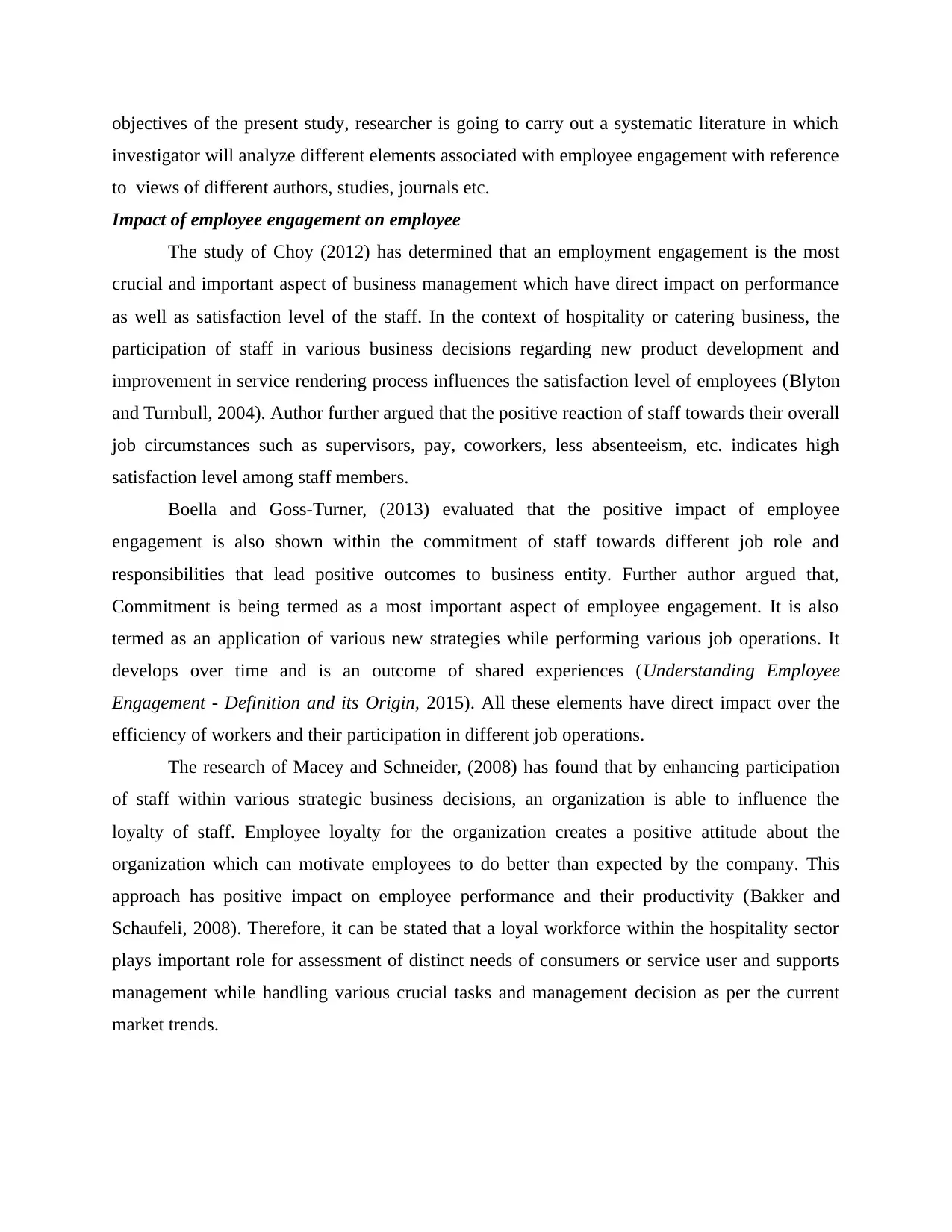
objectives of the present study, researcher is going to carry out a systematic literature in which
investigator will analyze different elements associated with employee engagement with reference
to views of different authors, studies, journals etc.
Impact of employee engagement on employee
The study of Choy (2012) has determined that an employment engagement is the most
crucial and important aspect of business management which have direct impact on performance
as well as satisfaction level of the staff. In the context of hospitality or catering business, the
participation of staff in various business decisions regarding new product development and
improvement in service rendering process influences the satisfaction level of employees (Blyton
and Turnbull, 2004). Author further argued that the positive reaction of staff towards their overall
job circumstances such as supervisors, pay, coworkers, less absenteeism, etc. indicates high
satisfaction level among staff members.
Boella and Goss-Turner, (2013) evaluated that the positive impact of employee
engagement is also shown within the commitment of staff towards different job role and
responsibilities that lead positive outcomes to business entity. Further author argued that,
Commitment is being termed as a most important aspect of employee engagement. It is also
termed as an application of various new strategies while performing various job operations. It
develops over time and is an outcome of shared experiences (Understanding Employee
Engagement - Definition and its Origin, 2015). All these elements have direct impact over the
efficiency of workers and their participation in different job operations.
The research of Macey and Schneider, (2008) has found that by enhancing participation
of staff within various strategic business decisions, an organization is able to influence the
loyalty of staff. Employee loyalty for the organization creates a positive attitude about the
organization which can motivate employees to do better than expected by the company. This
approach has positive impact on employee performance and their productivity (Bakker and
Schaufeli, 2008). Therefore, it can be stated that a loyal workforce within the hospitality sector
plays important role for assessment of distinct needs of consumers or service user and supports
management while handling various crucial tasks and management decision as per the current
market trends.
investigator will analyze different elements associated with employee engagement with reference
to views of different authors, studies, journals etc.
Impact of employee engagement on employee
The study of Choy (2012) has determined that an employment engagement is the most
crucial and important aspect of business management which have direct impact on performance
as well as satisfaction level of the staff. In the context of hospitality or catering business, the
participation of staff in various business decisions regarding new product development and
improvement in service rendering process influences the satisfaction level of employees (Blyton
and Turnbull, 2004). Author further argued that the positive reaction of staff towards their overall
job circumstances such as supervisors, pay, coworkers, less absenteeism, etc. indicates high
satisfaction level among staff members.
Boella and Goss-Turner, (2013) evaluated that the positive impact of employee
engagement is also shown within the commitment of staff towards different job role and
responsibilities that lead positive outcomes to business entity. Further author argued that,
Commitment is being termed as a most important aspect of employee engagement. It is also
termed as an application of various new strategies while performing various job operations. It
develops over time and is an outcome of shared experiences (Understanding Employee
Engagement - Definition and its Origin, 2015). All these elements have direct impact over the
efficiency of workers and their participation in different job operations.
The research of Macey and Schneider, (2008) has found that by enhancing participation
of staff within various strategic business decisions, an organization is able to influence the
loyalty of staff. Employee loyalty for the organization creates a positive attitude about the
organization which can motivate employees to do better than expected by the company. This
approach has positive impact on employee performance and their productivity (Bakker and
Schaufeli, 2008). Therefore, it can be stated that a loyal workforce within the hospitality sector
plays important role for assessment of distinct needs of consumers or service user and supports
management while handling various crucial tasks and management decision as per the current
market trends.
Paraphrase This Document
Need a fresh take? Get an instant paraphrase of this document with our AI Paraphraser
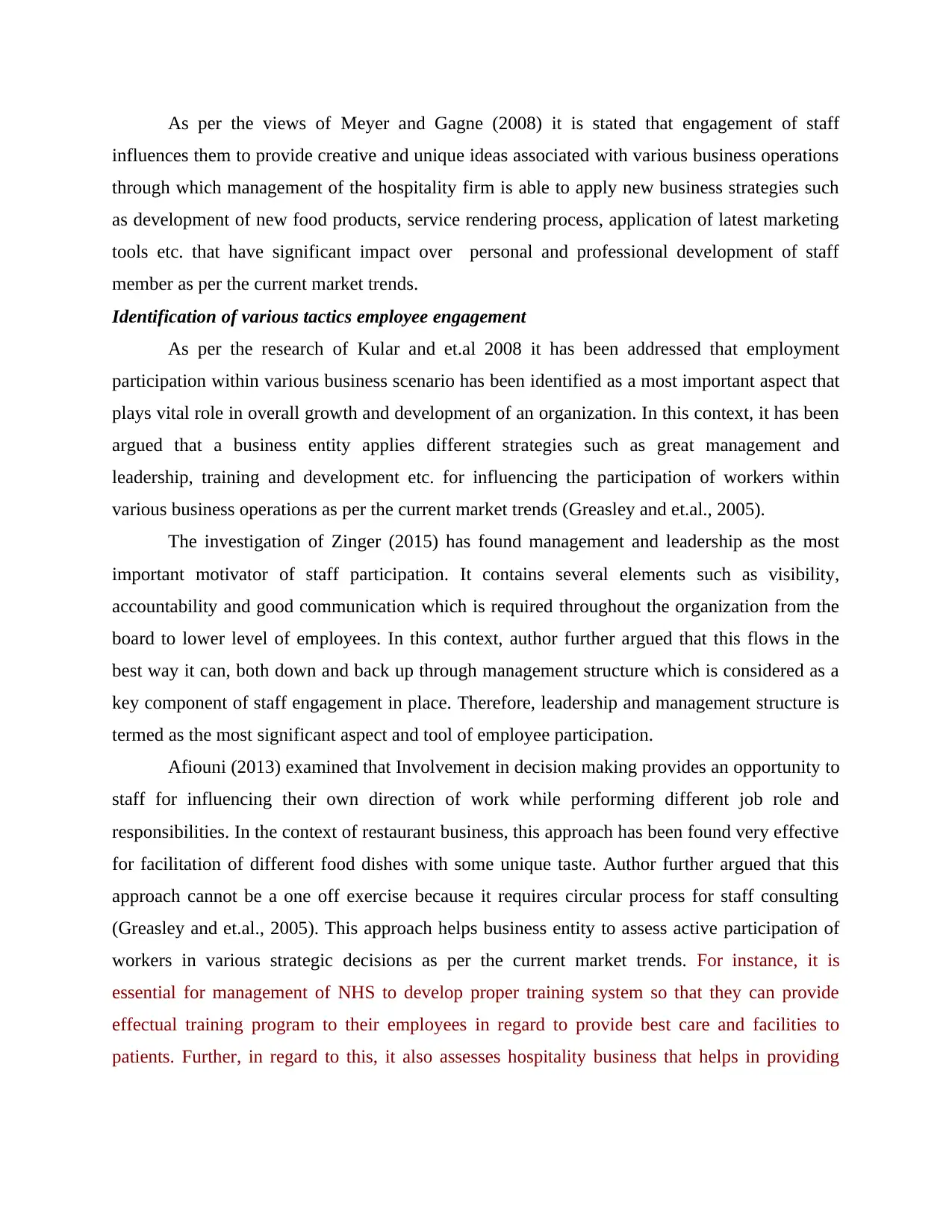
As per the views of Meyer and Gagne (2008) it is stated that engagement of staff
influences them to provide creative and unique ideas associated with various business operations
through which management of the hospitality firm is able to apply new business strategies such
as development of new food products, service rendering process, application of latest marketing
tools etc. that have significant impact over personal and professional development of staff
member as per the current market trends.
Identification of various tactics employee engagement
As per the research of Kular and et.al 2008 it has been addressed that employment
participation within various business scenario has been identified as a most important aspect that
plays vital role in overall growth and development of an organization. In this context, it has been
argued that a business entity applies different strategies such as great management and
leadership, training and development etc. for influencing the participation of workers within
various business operations as per the current market trends (Greasley and et.al., 2005).
The investigation of Zinger (2015) has found management and leadership as the most
important motivator of staff participation. It contains several elements such as visibility,
accountability and good communication which is required throughout the organization from the
board to lower level of employees. In this context, author further argued that this flows in the
best way it can, both down and back up through management structure which is considered as a
key component of staff engagement in place. Therefore, leadership and management structure is
termed as the most significant aspect and tool of employee participation.
Afiouni (2013) examined that Involvement in decision making provides an opportunity to
staff for influencing their own direction of work while performing different job role and
responsibilities. In the context of restaurant business, this approach has been found very effective
for facilitation of different food dishes with some unique taste. Author further argued that this
approach cannot be a one off exercise because it requires circular process for staff consulting
(Greasley and et.al., 2005). This approach helps business entity to assess active participation of
workers in various strategic decisions as per the current market trends. For instance, it is
essential for management of NHS to develop proper training system so that they can provide
effectual training program to their employees in regard to provide best care and facilities to
patients. Further, in regard to this, it also assesses hospitality business that helps in providing
influences them to provide creative and unique ideas associated with various business operations
through which management of the hospitality firm is able to apply new business strategies such
as development of new food products, service rendering process, application of latest marketing
tools etc. that have significant impact over personal and professional development of staff
member as per the current market trends.
Identification of various tactics employee engagement
As per the research of Kular and et.al 2008 it has been addressed that employment
participation within various business scenario has been identified as a most important aspect that
plays vital role in overall growth and development of an organization. In this context, it has been
argued that a business entity applies different strategies such as great management and
leadership, training and development etc. for influencing the participation of workers within
various business operations as per the current market trends (Greasley and et.al., 2005).
The investigation of Zinger (2015) has found management and leadership as the most
important motivator of staff participation. It contains several elements such as visibility,
accountability and good communication which is required throughout the organization from the
board to lower level of employees. In this context, author further argued that this flows in the
best way it can, both down and back up through management structure which is considered as a
key component of staff engagement in place. Therefore, leadership and management structure is
termed as the most significant aspect and tool of employee participation.
Afiouni (2013) examined that Involvement in decision making provides an opportunity to
staff for influencing their own direction of work while performing different job role and
responsibilities. In the context of restaurant business, this approach has been found very effective
for facilitation of different food dishes with some unique taste. Author further argued that this
approach cannot be a one off exercise because it requires circular process for staff consulting
(Greasley and et.al., 2005). This approach helps business entity to assess active participation of
workers in various strategic decisions as per the current market trends. For instance, it is
essential for management of NHS to develop proper training system so that they can provide
effectual training program to their employees in regard to provide best care and facilities to
patients. Further, in regard to this, it also assesses hospitality business that helps in providing
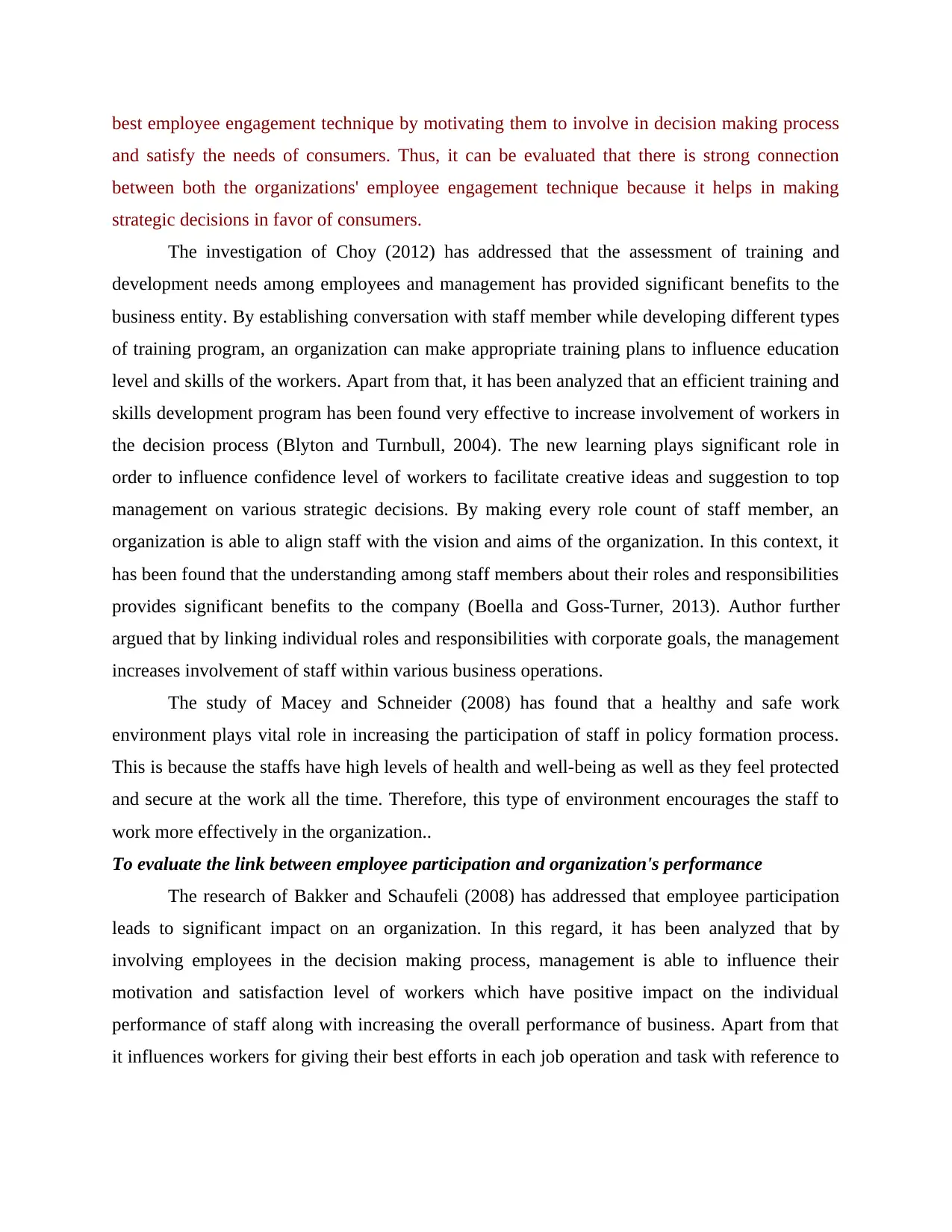
best employee engagement technique by motivating them to involve in decision making process
and satisfy the needs of consumers. Thus, it can be evaluated that there is strong connection
between both the organizations' employee engagement technique because it helps in making
strategic decisions in favor of consumers.
The investigation of Choy (2012) has addressed that the assessment of training and
development needs among employees and management has provided significant benefits to the
business entity. By establishing conversation with staff member while developing different types
of training program, an organization can make appropriate training plans to influence education
level and skills of the workers. Apart from that, it has been analyzed that an efficient training and
skills development program has been found very effective to increase involvement of workers in
the decision process (Blyton and Turnbull, 2004). The new learning plays significant role in
order to influence confidence level of workers to facilitate creative ideas and suggestion to top
management on various strategic decisions. By making every role count of staff member, an
organization is able to align staff with the vision and aims of the organization. In this context, it
has been found that the understanding among staff members about their roles and responsibilities
provides significant benefits to the company (Boella and Goss-Turner, 2013). Author further
argued that by linking individual roles and responsibilities with corporate goals, the management
increases involvement of staff within various business operations.
The study of Macey and Schneider (2008) has found that a healthy and safe work
environment plays vital role in increasing the participation of staff in policy formation process.
This is because the staffs have high levels of health and well-being as well as they feel protected
and secure at the work all the time. Therefore, this type of environment encourages the staff to
work more effectively in the organization..
To evaluate the link between employee participation and organization's performance
The research of Bakker and Schaufeli (2008) has addressed that employee participation
leads to significant impact on an organization. In this regard, it has been analyzed that by
involving employees in the decision making process, management is able to influence their
motivation and satisfaction level of workers which have positive impact on the individual
performance of staff along with increasing the overall performance of business. Apart from that
it influences workers for giving their best efforts in each job operation and task with reference to
and satisfy the needs of consumers. Thus, it can be evaluated that there is strong connection
between both the organizations' employee engagement technique because it helps in making
strategic decisions in favor of consumers.
The investigation of Choy (2012) has addressed that the assessment of training and
development needs among employees and management has provided significant benefits to the
business entity. By establishing conversation with staff member while developing different types
of training program, an organization can make appropriate training plans to influence education
level and skills of the workers. Apart from that, it has been analyzed that an efficient training and
skills development program has been found very effective to increase involvement of workers in
the decision process (Blyton and Turnbull, 2004). The new learning plays significant role in
order to influence confidence level of workers to facilitate creative ideas and suggestion to top
management on various strategic decisions. By making every role count of staff member, an
organization is able to align staff with the vision and aims of the organization. In this context, it
has been found that the understanding among staff members about their roles and responsibilities
provides significant benefits to the company (Boella and Goss-Turner, 2013). Author further
argued that by linking individual roles and responsibilities with corporate goals, the management
increases involvement of staff within various business operations.
The study of Macey and Schneider (2008) has found that a healthy and safe work
environment plays vital role in increasing the participation of staff in policy formation process.
This is because the staffs have high levels of health and well-being as well as they feel protected
and secure at the work all the time. Therefore, this type of environment encourages the staff to
work more effectively in the organization..
To evaluate the link between employee participation and organization's performance
The research of Bakker and Schaufeli (2008) has addressed that employee participation
leads to significant impact on an organization. In this regard, it has been analyzed that by
involving employees in the decision making process, management is able to influence their
motivation and satisfaction level of workers which have positive impact on the individual
performance of staff along with increasing the overall performance of business. Apart from that
it influences workers for giving their best efforts in each job operation and task with reference to
⊘ This is a preview!⊘
Do you want full access?
Subscribe today to unlock all pages.

Trusted by 1+ million students worldwide
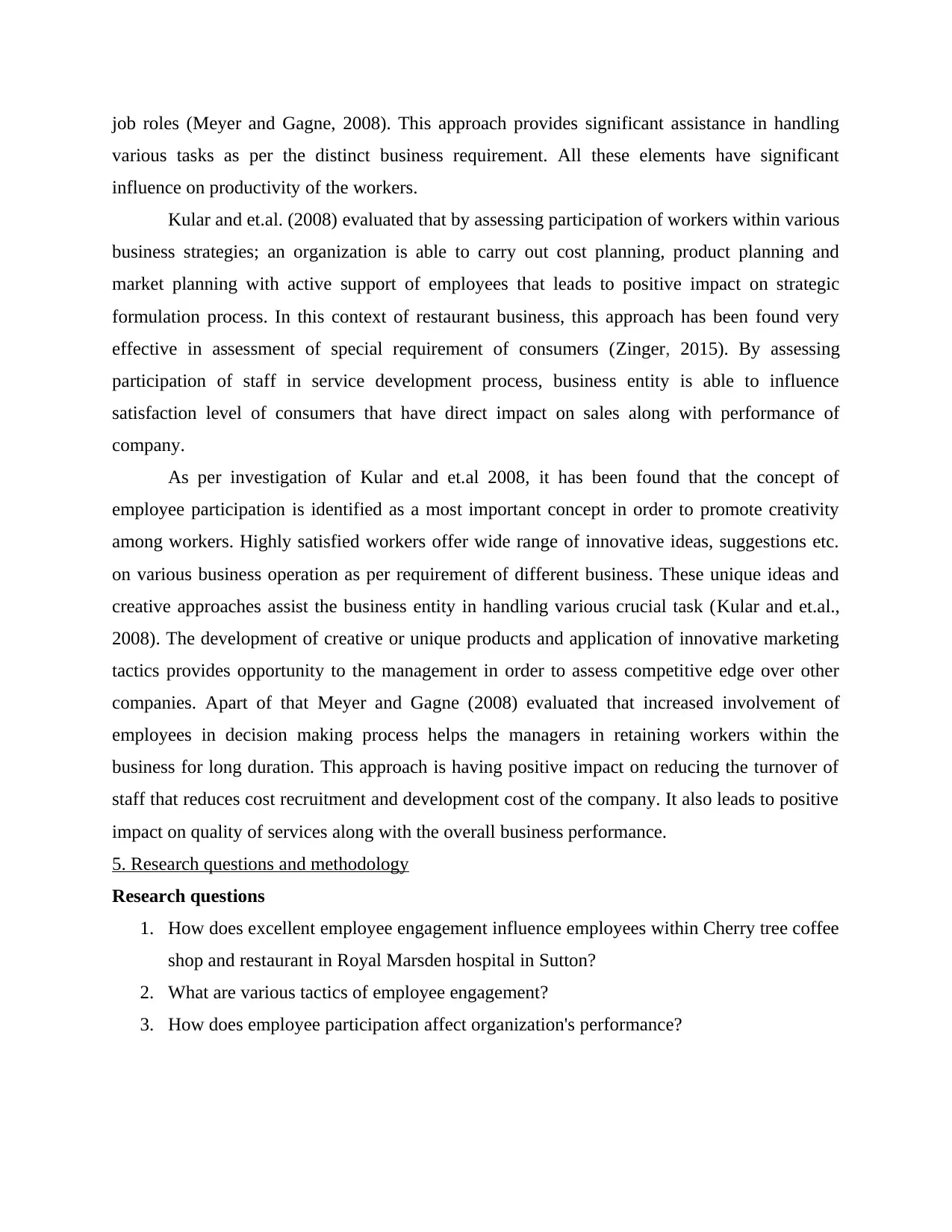
job roles (Meyer and Gagne, 2008). This approach provides significant assistance in handling
various tasks as per the distinct business requirement. All these elements have significant
influence on productivity of the workers.
Kular and et.al. (2008) evaluated that by assessing participation of workers within various
business strategies; an organization is able to carry out cost planning, product planning and
market planning with active support of employees that leads to positive impact on strategic
formulation process. In this context of restaurant business, this approach has been found very
effective in assessment of special requirement of consumers (Zinger, 2015). By assessing
participation of staff in service development process, business entity is able to influence
satisfaction level of consumers that have direct impact on sales along with performance of
company.
As per investigation of Kular and et.al 2008, it has been found that the concept of
employee participation is identified as a most important concept in order to promote creativity
among workers. Highly satisfied workers offer wide range of innovative ideas, suggestions etc.
on various business operation as per requirement of different business. These unique ideas and
creative approaches assist the business entity in handling various crucial task (Kular and et.al.,
2008). The development of creative or unique products and application of innovative marketing
tactics provides opportunity to the management in order to assess competitive edge over other
companies. Apart of that Meyer and Gagne (2008) evaluated that increased involvement of
employees in decision making process helps the managers in retaining workers within the
business for long duration. This approach is having positive impact on reducing the turnover of
staff that reduces cost recruitment and development cost of the company. It also leads to positive
impact on quality of services along with the overall business performance.
5. Research questions and methodology
Research questions
1. How does excellent employee engagement influence employees within Cherry tree coffee
shop and restaurant in Royal Marsden hospital in Sutton?
2. What are various tactics of employee engagement?
3. How does employee participation affect organization's performance?
various tasks as per the distinct business requirement. All these elements have significant
influence on productivity of the workers.
Kular and et.al. (2008) evaluated that by assessing participation of workers within various
business strategies; an organization is able to carry out cost planning, product planning and
market planning with active support of employees that leads to positive impact on strategic
formulation process. In this context of restaurant business, this approach has been found very
effective in assessment of special requirement of consumers (Zinger, 2015). By assessing
participation of staff in service development process, business entity is able to influence
satisfaction level of consumers that have direct impact on sales along with performance of
company.
As per investigation of Kular and et.al 2008, it has been found that the concept of
employee participation is identified as a most important concept in order to promote creativity
among workers. Highly satisfied workers offer wide range of innovative ideas, suggestions etc.
on various business operation as per requirement of different business. These unique ideas and
creative approaches assist the business entity in handling various crucial task (Kular and et.al.,
2008). The development of creative or unique products and application of innovative marketing
tactics provides opportunity to the management in order to assess competitive edge over other
companies. Apart of that Meyer and Gagne (2008) evaluated that increased involvement of
employees in decision making process helps the managers in retaining workers within the
business for long duration. This approach is having positive impact on reducing the turnover of
staff that reduces cost recruitment and development cost of the company. It also leads to positive
impact on quality of services along with the overall business performance.
5. Research questions and methodology
Research questions
1. How does excellent employee engagement influence employees within Cherry tree coffee
shop and restaurant in Royal Marsden hospital in Sutton?
2. What are various tactics of employee engagement?
3. How does employee participation affect organization's performance?
Paraphrase This Document
Need a fresh take? Get an instant paraphrase of this document with our AI Paraphraser
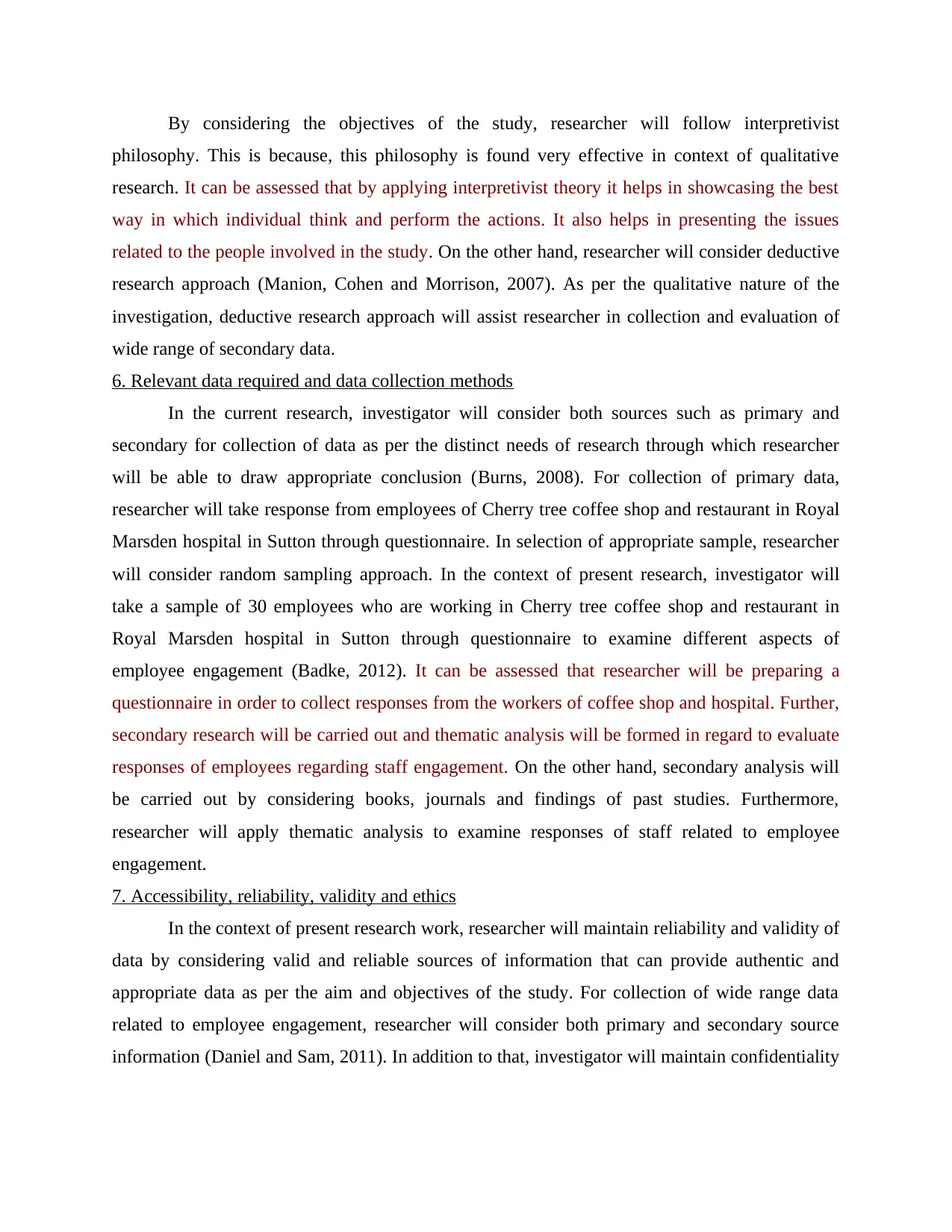
By considering the objectives of the study, researcher will follow interpretivist
philosophy. This is because, this philosophy is found very effective in context of qualitative
research. It can be assessed that by applying interpretivist theory it helps in showcasing the best
way in which individual think and perform the actions. It also helps in presenting the issues
related to the people involved in the study. On the other hand, researcher will consider deductive
research approach (Manion, Cohen and Morrison, 2007). As per the qualitative nature of the
investigation, deductive research approach will assist researcher in collection and evaluation of
wide range of secondary data.
6. Relevant data required and data collection methods
In the current research, investigator will consider both sources such as primary and
secondary for collection of data as per the distinct needs of research through which researcher
will be able to draw appropriate conclusion (Burns, 2008). For collection of primary data,
researcher will take response from employees of Cherry tree coffee shop and restaurant in Royal
Marsden hospital in Sutton through questionnaire. In selection of appropriate sample, researcher
will consider random sampling approach. In the context of present research, investigator will
take a sample of 30 employees who are working in Cherry tree coffee shop and restaurant in
Royal Marsden hospital in Sutton through questionnaire to examine different aspects of
employee engagement (Badke, 2012). It can be assessed that researcher will be preparing a
questionnaire in order to collect responses from the workers of coffee shop and hospital. Further,
secondary research will be carried out and thematic analysis will be formed in regard to evaluate
responses of employees regarding staff engagement. On the other hand, secondary analysis will
be carried out by considering books, journals and findings of past studies. Furthermore,
researcher will apply thematic analysis to examine responses of staff related to employee
engagement.
7. Accessibility, reliability, validity and ethics
In the context of present research work, researcher will maintain reliability and validity of
data by considering valid and reliable sources of information that can provide authentic and
appropriate data as per the aim and objectives of the study. For collection of wide range data
related to employee engagement, researcher will consider both primary and secondary source
information (Daniel and Sam, 2011). In addition to that, investigator will maintain confidentiality
philosophy. This is because, this philosophy is found very effective in context of qualitative
research. It can be assessed that by applying interpretivist theory it helps in showcasing the best
way in which individual think and perform the actions. It also helps in presenting the issues
related to the people involved in the study. On the other hand, researcher will consider deductive
research approach (Manion, Cohen and Morrison, 2007). As per the qualitative nature of the
investigation, deductive research approach will assist researcher in collection and evaluation of
wide range of secondary data.
6. Relevant data required and data collection methods
In the current research, investigator will consider both sources such as primary and
secondary for collection of data as per the distinct needs of research through which researcher
will be able to draw appropriate conclusion (Burns, 2008). For collection of primary data,
researcher will take response from employees of Cherry tree coffee shop and restaurant in Royal
Marsden hospital in Sutton through questionnaire. In selection of appropriate sample, researcher
will consider random sampling approach. In the context of present research, investigator will
take a sample of 30 employees who are working in Cherry tree coffee shop and restaurant in
Royal Marsden hospital in Sutton through questionnaire to examine different aspects of
employee engagement (Badke, 2012). It can be assessed that researcher will be preparing a
questionnaire in order to collect responses from the workers of coffee shop and hospital. Further,
secondary research will be carried out and thematic analysis will be formed in regard to evaluate
responses of employees regarding staff engagement. On the other hand, secondary analysis will
be carried out by considering books, journals and findings of past studies. Furthermore,
researcher will apply thematic analysis to examine responses of staff related to employee
engagement.
7. Accessibility, reliability, validity and ethics
In the context of present research work, researcher will maintain reliability and validity of
data by considering valid and reliable sources of information that can provide authentic and
appropriate data as per the aim and objectives of the study. For collection of wide range data
related to employee engagement, researcher will consider both primary and secondary source
information (Daniel and Sam, 2011). In addition to that, investigator will maintain confidentiality
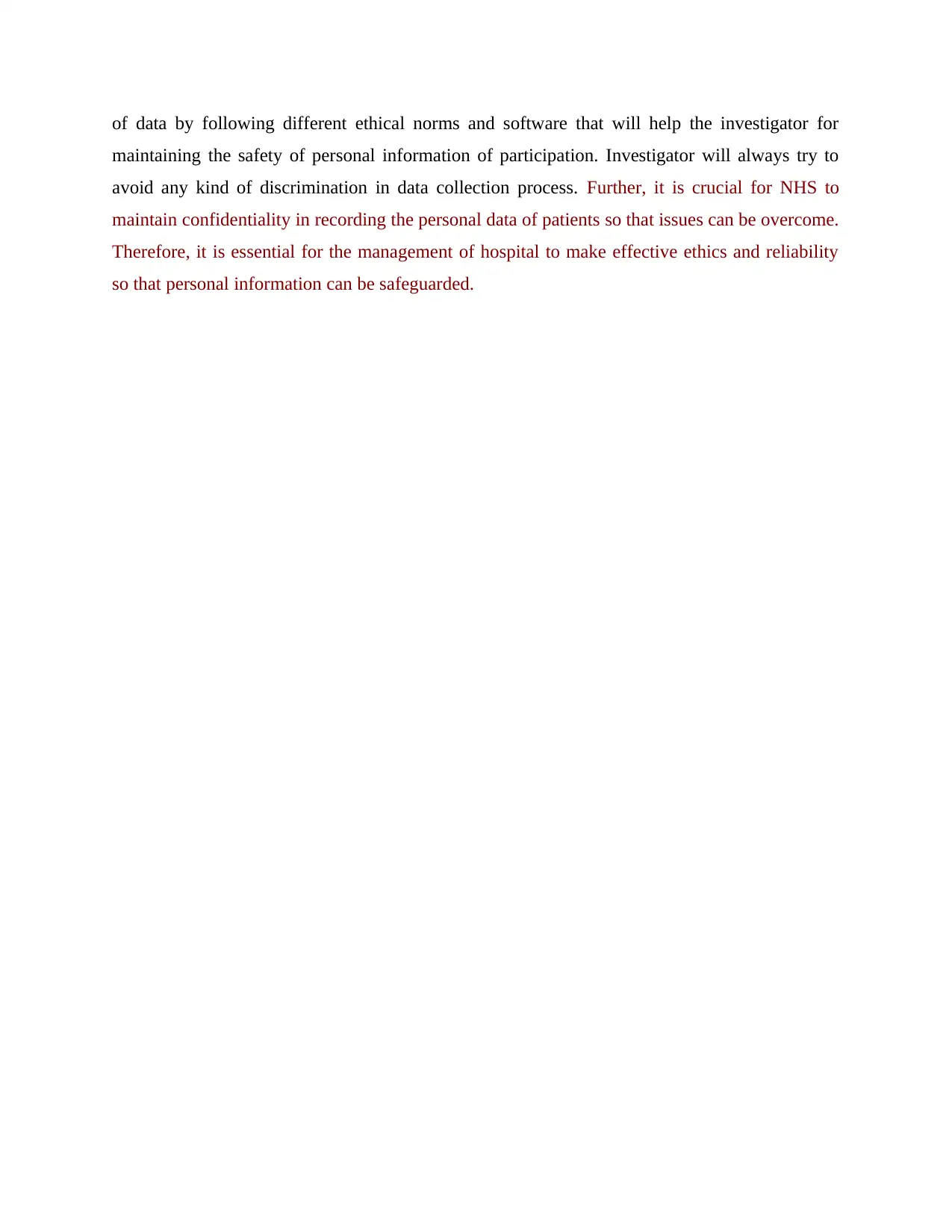
of data by following different ethical norms and software that will help the investigator for
maintaining the safety of personal information of participation. Investigator will always try to
avoid any kind of discrimination in data collection process. Further, it is crucial for NHS to
maintain confidentiality in recording the personal data of patients so that issues can be overcome.
Therefore, it is essential for the management of hospital to make effective ethics and reliability
so that personal information can be safeguarded.
maintaining the safety of personal information of participation. Investigator will always try to
avoid any kind of discrimination in data collection process. Further, it is crucial for NHS to
maintain confidentiality in recording the personal data of patients so that issues can be overcome.
Therefore, it is essential for the management of hospital to make effective ethics and reliability
so that personal information can be safeguarded.
⊘ This is a preview!⊘
Do you want full access?
Subscribe today to unlock all pages.

Trusted by 1+ million students worldwide
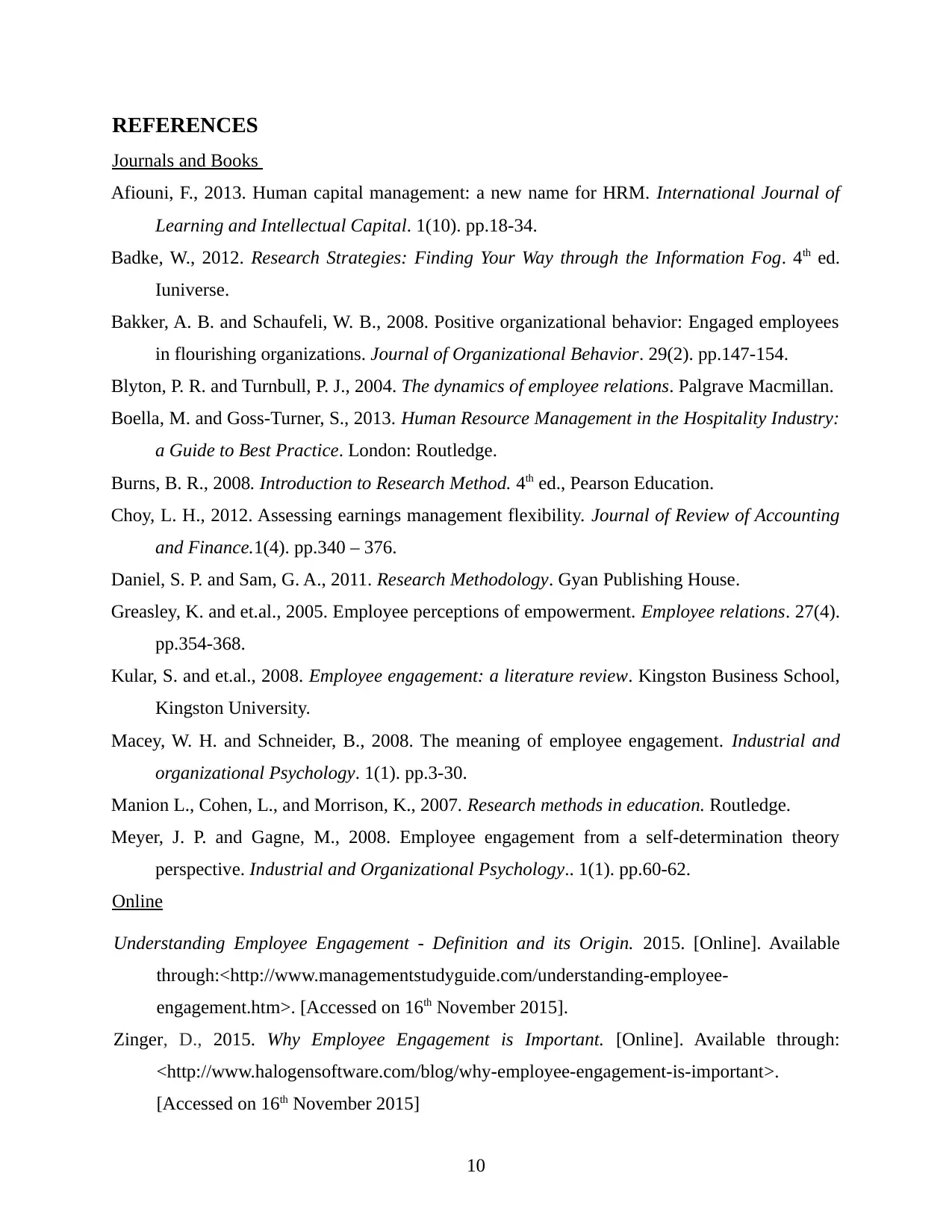
REFERENCES
Journals and Books
Afiouni, F., 2013. Human capital management: a new name for HRM. International Journal of
Learning and Intellectual Capital. 1(10). pp.18-34.
Badke, W., 2012. Research Strategies: Finding Your Way through the Information Fog. 4th ed.
Iuniverse.
Bakker, A. B. and Schaufeli, W. B., 2008. Positive organizational behavior: Engaged employees
in flourishing organizations. Journal of Organizational Behavior. 29(2). pp.147-154.
Blyton, P. R. and Turnbull, P. J., 2004. The dynamics of employee relations. Palgrave Macmillan.
Boella, M. and Goss-Turner, S., 2013. Human Resource Management in the Hospitality Industry:
a Guide to Best Practice. London: Routledge.
Burns, B. R., 2008. Introduction to Research Method. 4th ed., Pearson Education.
Choy, L. H., 2012. Assessing earnings management flexibility. Journal of Review of Accounting
and Finance.1(4). pp.340 – 376.
Daniel, S. P. and Sam, G. A., 2011. Research Methodology. Gyan Publishing House.
Greasley, K. and et.al., 2005. Employee perceptions of empowerment. Employee relations. 27(4).
pp.354-368.
Kular, S. and et.al., 2008. Employee engagement: a literature review. Kingston Business School,
Kingston University.
Macey, W. H. and Schneider, B., 2008. The meaning of employee engagement. Industrial and
organizational Psychology. 1(1). pp.3-30.
Manion L., Cohen, L., and Morrison, K., 2007. Research methods in education. Routledge.
Meyer, J. P. and Gagne, M., 2008. Employee engagement from a self‐determination theory
perspective. Industrial and Organizational Psychology.. 1(1). pp.60-62.
Online
Understanding Employee Engagement - Definition and its Origin. 2015. [Online]. Available
through:<http://www.managementstudyguide.com/understanding-employee-
engagement.htm>. [Accessed on 16th November 2015].
Zinger, D., 2015. Why Employee Engagement is Important. [Online]. Available through:
<http://www.halogensoftware.com/blog/why-employee-engagement-is-important>.
[Accessed on 16th November 2015]
10
Journals and Books
Afiouni, F., 2013. Human capital management: a new name for HRM. International Journal of
Learning and Intellectual Capital. 1(10). pp.18-34.
Badke, W., 2012. Research Strategies: Finding Your Way through the Information Fog. 4th ed.
Iuniverse.
Bakker, A. B. and Schaufeli, W. B., 2008. Positive organizational behavior: Engaged employees
in flourishing organizations. Journal of Organizational Behavior. 29(2). pp.147-154.
Blyton, P. R. and Turnbull, P. J., 2004. The dynamics of employee relations. Palgrave Macmillan.
Boella, M. and Goss-Turner, S., 2013. Human Resource Management in the Hospitality Industry:
a Guide to Best Practice. London: Routledge.
Burns, B. R., 2008. Introduction to Research Method. 4th ed., Pearson Education.
Choy, L. H., 2012. Assessing earnings management flexibility. Journal of Review of Accounting
and Finance.1(4). pp.340 – 376.
Daniel, S. P. and Sam, G. A., 2011. Research Methodology. Gyan Publishing House.
Greasley, K. and et.al., 2005. Employee perceptions of empowerment. Employee relations. 27(4).
pp.354-368.
Kular, S. and et.al., 2008. Employee engagement: a literature review. Kingston Business School,
Kingston University.
Macey, W. H. and Schneider, B., 2008. The meaning of employee engagement. Industrial and
organizational Psychology. 1(1). pp.3-30.
Manion L., Cohen, L., and Morrison, K., 2007. Research methods in education. Routledge.
Meyer, J. P. and Gagne, M., 2008. Employee engagement from a self‐determination theory
perspective. Industrial and Organizational Psychology.. 1(1). pp.60-62.
Online
Understanding Employee Engagement - Definition and its Origin. 2015. [Online]. Available
through:<http://www.managementstudyguide.com/understanding-employee-
engagement.htm>. [Accessed on 16th November 2015].
Zinger, D., 2015. Why Employee Engagement is Important. [Online]. Available through:
<http://www.halogensoftware.com/blog/why-employee-engagement-is-important>.
[Accessed on 16th November 2015]
10
Paraphrase This Document
Need a fresh take? Get an instant paraphrase of this document with our AI Paraphraser
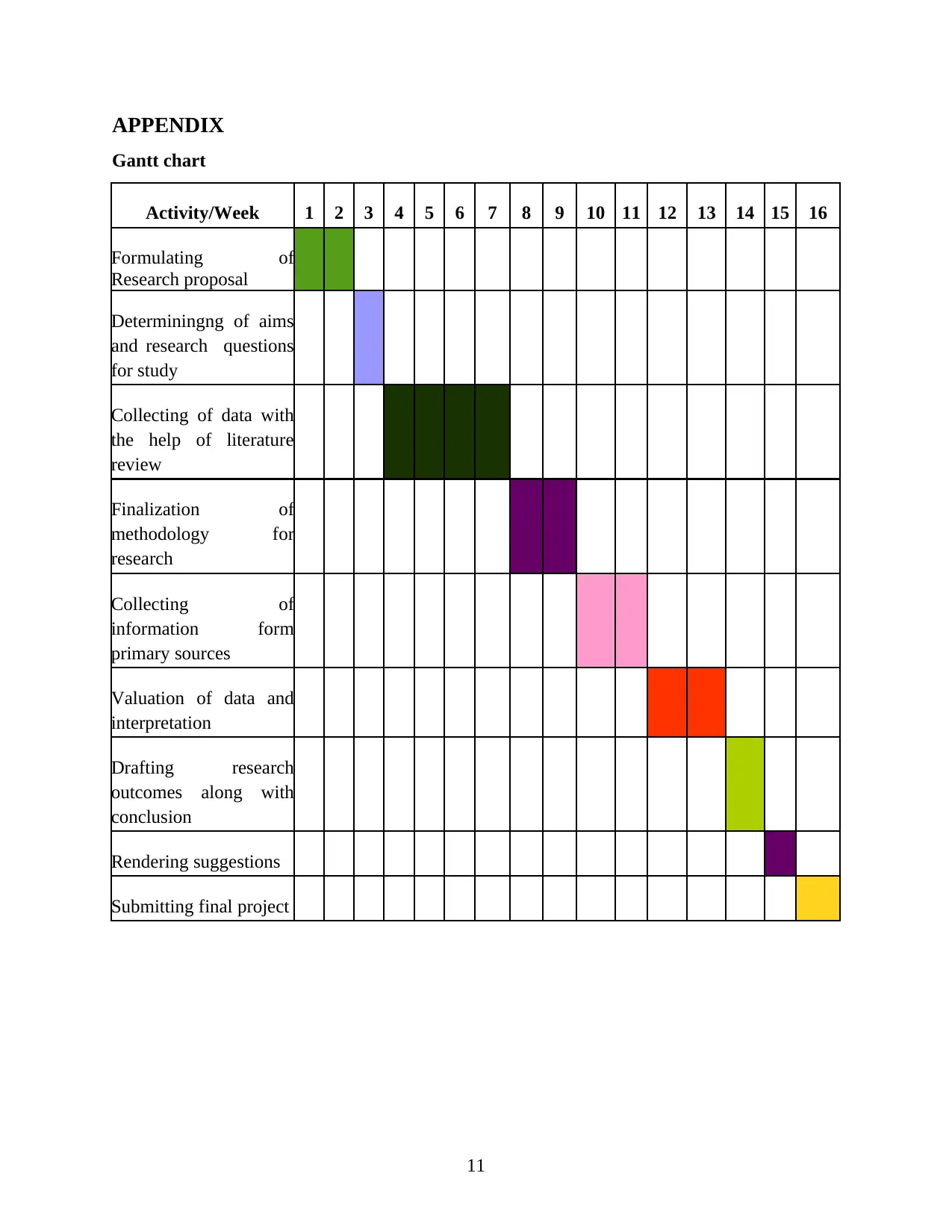
APPENDIX
Gantt chart
Activity/Week 1 2 3 4 5 6 7 8 9 10 11 12 13 14 15 16
Formulating of
Research proposal
Determiningng of aims
and research questions
for study
Collecting of data with
the help of literature
review
Finalization of
methodology for
research
Collecting of
information form
primary sources
Valuation of data and
interpretation
Drafting research
outcomes along with
conclusion
Rendering suggestions
Submitting final project
11
Gantt chart
Activity/Week 1 2 3 4 5 6 7 8 9 10 11 12 13 14 15 16
Formulating of
Research proposal
Determiningng of aims
and research questions
for study
Collecting of data with
the help of literature
review
Finalization of
methodology for
research
Collecting of
information form
primary sources
Valuation of data and
interpretation
Drafting research
outcomes along with
conclusion
Rendering suggestions
Submitting final project
11
1 out of 11
Related Documents
Your All-in-One AI-Powered Toolkit for Academic Success.
+13062052269
info@desklib.com
Available 24*7 on WhatsApp / Email
![[object Object]](/_next/static/media/star-bottom.7253800d.svg)
Unlock your academic potential
Copyright © 2020–2025 A2Z Services. All Rights Reserved. Developed and managed by ZUCOL.





